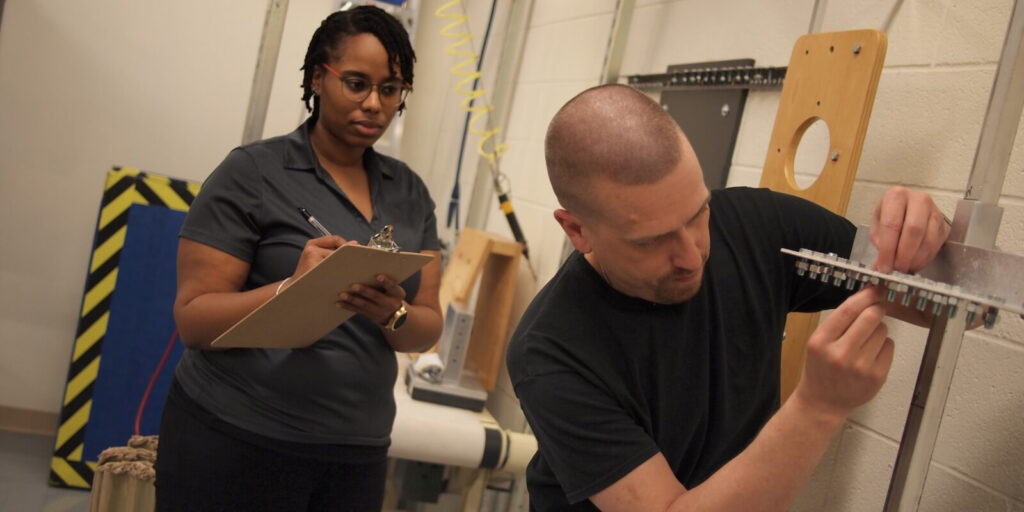Functional employment testing can make a big difference for your organization, from reducing new-hire injuries to increasing employee retention . And while employment testing is more well-known and accepted today than it was 10 or 20 years ago, there are still widespread misconceptions as to what exactly functional employment testing is and how it can best be implemented to serve your organization.
Here is a closer look at a few of those misconceptions followed by a breakdown of what employment testing is and how it can benefit your employees and your business.
Employment testing IS NOT a psychological or cognitive exam
It’s often assumed functional employment testing will include psychological or mental aspects to assess the candidate’s ability to perform in their prospective role from a cognitive standpoint. While this is an important factor in interviewing and screening potential employees, it is not considered to be a part of functional employment testing, which is concerned strictly with a candidate’s ability to physically perform the essential functions of the job.
Employment testing IS NOT an equipment competency test
Another important factor often thought to be included in functional employment testing is equipment competency. Take forklift operation, for example. When hiring for a role that will frequently operate a forklift, the candidate’s ability to do so from a technical standpoint would not be a component of their functional employment test. This is job-specific training the employee would be likely to receive later on.
What may be included, however, is a test to assess the candidate’s ability to easily look behind themselves in either direction while operating the forklift. This could be considered an essential physical function of the position, and would thus be a necessary aspect of the employment test.
Employment testing IS NOT a physical fitness test
Older testing protocols would in some cases ask candidates to perform physical fitness activities like push-ups or sit-ups, but this methodology has since fallen by the wayside. While physical fitness may be an important attribute for a prospective employee depending on the role, the EEOC states employment testing must be “job-related and consistent with business necessity.” Push-ups and sit-ups do not meet this criteria unless one’s job specifically entails performance of these exercises as an essential function. Including push-ups and sit-ups as “capable” and “not capable” criteria of testing could also set the employer up for potential ADA/EOCC issues down the road.
Instead, physical activities relevant to the specific role should serve as the basis of the tests, such as push/pull exercises or the simulation of lifting certain weights and objects across certain distances or to certain heights.
Employment testing IS NOT designed to hire “perfect” candidates
When employers first begin researching employment testing, many expect the end result to be the hiring of “perfect” candidates tailor-made for each position within the organization. The reality is there is no such thing as a “perfect” candidate, as the vast majority have experienced some form of medical or musculoskeletal issue during their life or career thus far.
Rather than striving to hire idealistic versions of completely flawless candidates, employment testing aims to hire those that are medically stable and functionally able to meet the physical demands of the job.
So… What IS employment testing?
The ultimate goal of functional employment testing is to assess a candidate’s ability to physically perform the essential functions of the position for which they are being hired. Therefore, the format and execution of the testing needs to reflect this. If a candidate will need to lift 50 pounds multiple times per day, their employment test should confirm their ability to do so.
The criteria for effective employment testing is determined first and foremost through a Physical Demands Analysis (PDA) of all positions in need of testing. The PDA thoroughly reviews each position through observation and analysis of the job and its tasks, interviews with employees and supervisors, measurement of material handling demands, and more. The PDA is then leveraged by Certified Professional Ergonomists (CPEs) to develop job-specific tests that simulate the essential functions of the role as closely as possible.
The most common type of employment testing is post-offer testing, which is performed after the contingent offer is made by the employer but before the candidate begins working. Post-offer testing can include a medical history review, comprehensive musculoskeletal evaluation, dynamic lifting and job-specific testing, and more.
Say a candidate has a history of back surgeries with ongoing pain and is unable to safely demonstrate their ability to perform the physical demands of the test, specifically due to this medical condition. Following an interactive dialogue process with the candidate, the employer could legally withdraw the offer of employment, if reasonable accommodations did not exist.
The same is true if the candidate demonstrates the ability to meet the physical demands of the test, but is found to have a significant medical condition that would place them at imminent risk of injuring themselves or others if placed in the job position.
This is functional employment testing at work, and just as it can prevent your business from hiring unfit or unsafe employees, it can also help you hire the best candidates who are more likely to succeed safely in their roles for years to come.
Start hiring the right candidates with employment testing from Fit For Work
Fit For Work is a licensed provider of WorkSTEPS employment testing, meaning we perform testing protocols as outlined by the WorkSTEPS model. Our staff receive biannual training and additional refresher courses to remain up-to-date on the latest changes in employment law regulation and testing compliance.
Not only do we perform industry-best employment testing, but we do so onsite by coming to you wherever you are, resulting in larger testing volume, more accurate job simulation, prompt scheduling and testing of candidates, and more. Bringing employment testing onsite allows our clients to achieve a more streamlined hiring process with reductions to onboarding times for new hires while still meeting goals for the new hire contingencies of drug and functional testing and background screens.
Through functional employment testing, employers are able to see a 50% reduction in injuries and associated costs within the first year of testing, with additional reductions possible in the years that follow.
Contact us today to begin crafting employment tests designed to decrease injuries while increasing productivity, morale, and retention.





